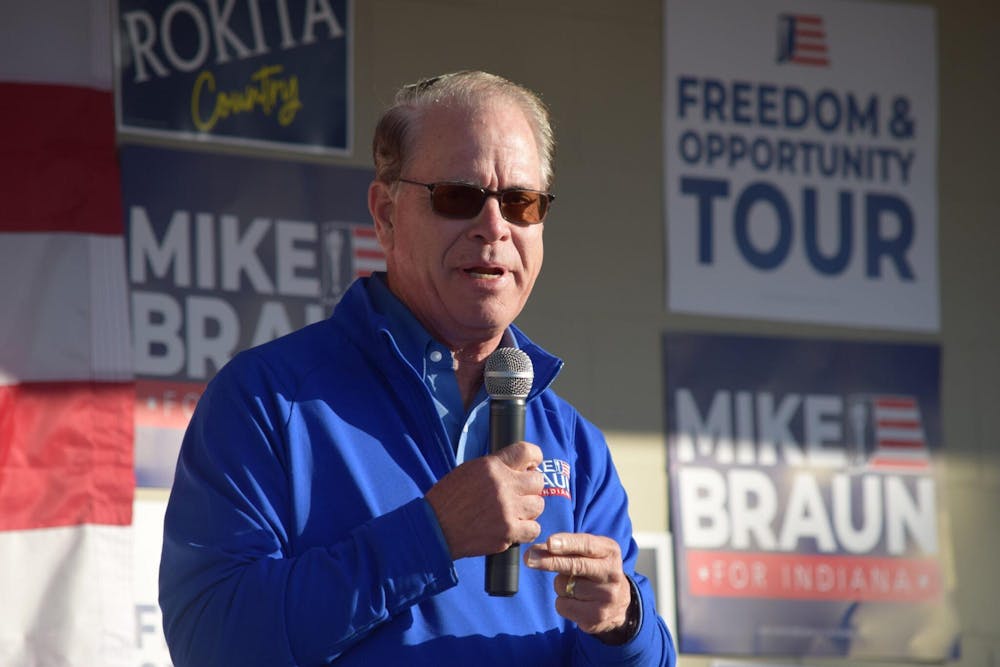In recent weeks, Indiana Gov. Mike Braun signed two executive orders establishing his approach to statewide environmental policy. Whether these orders will spell substantive change for the state is unclear, experts told the Indiana Daily Student.
Executive Order 25-38 states Indiana will not adopt new environmental regulations that are more stringent than federal standards. Executive Order 25-37 stipulates that state agencies can’t consider environmental justice in crafting environmental policy and that such policy will instead be informed by “sound science” alone.
In response to a request for comment, Braun’s team forwarded the IDS a prior press release that said state environmental standards beyond federal requirements are responsible for “stifling innovation and raising the cost of living.” Braun’s policies, the release said, would aim to preserve natural resources and bolster Indiana’s economy.
“Indiana has always been a difficult state on the environment,” David Van Gilder, senior policy and legal director for the Hoosier Environmental Council, said. “It’s very agricultural but also has a lot of industry. Politicians want to create jobs and bring more business to the state, and those priorities often get placed above protecting human health and land.”
Executive Order 25-38 is not the first instance of Indiana’s government trying to prevent environmental “over-regulation.” In 2017, the Indiana General Assembly overrode then-Gov. Eric Holcomb’s veto of a bill that prohibits the state’s environmental regulation rules board from adopting environmental laws more restrictive than those on the federal level. Although the law still allows the General Assembly to pass such legislation, the laws can’t go into effect until after the adjournment of the next legislative session, opening a door for the General Assembly to override them.
So why the redundancy?
The landscape of federal environmental practices is evolving by the day. Environmental Protection Agency Director Lee Zeldin committed to overhauling 31 different regulatory standards, including acceptable air toxics levels and emissions thresholds.
Steven Vigdor, a retired physics professor and leader within Concerned Scientists at IU, said these shifts could make the would-be symbolic Executive Order 25-38 a more serious consideration.
“Braun now understands how much Zeldin is trying to roll back federal guidelines on the environment,” Vigdor said. “If Zeldin succeeds, then Braun’s executive order starts to take a very significant effect: as the federal government moves away from any responsibility on climate, it’s up to the states to try to maintain standards.”
Vigdor said lower federal minimums on the environment could mean lower Indiana minimums, too.
“It’s a real danger — it’s basically burying one’s head in the sand about what’s going on in nature,” Vigdor said.
Janet McCabe, deputy administrator of the EPA under the Biden administration, echoed Vigdor’s comments.
“The last thing you want to do is spend years working on regulation and have it be untethered from the real world,” McCabe said. “The sun will come up today whether you say it is or not. The Earth is going to do what it’s going to do, regardless of what people are saying in Washington.”
Executive Order 25-37 suggests that the sound science backing conservation is at odds with environmental justice. The order argues that environmental justice, which considers how the impact of conservation and climate issues varies community-to-community, is often politically charged and introduces unnecessary subjectivity into the policymaking process.
However, Van Gilder said these notions miss the point of environmental justice.
“Environmental justice is about who has a seat at the table to decide how their community will develop and thrive,” Van Gilder said. “What’s missing is the realization that historically, those with the least voice are most affected by development choices.”
The executive orders counter some of Braun’s previous moves on environmental issues. In February, Braun pushed back against the Buffalo Springs Restoration Project, a U.S. Forest Service proposal to log and burn close to 20,000 acres of the Hoosier National Forest. Braun pointed to widespread public disapproval for the project, as well as its potential threats to recreation and a neighboring watershed supplying drinking water to over 100,000 Hoosiers. It was recently announced that the USFS agreed to pause the project.
McCabe said concerned citizens are not powerless against changes to science policy taking place on the state and federal levels. She cited the process of EPA rule-changing, which involves an opportunity for public input, as an example. The EPA is required to consider and respond to all relevant comments, providing everyday Americans a seat at the table of federal decision-making.
“We’re seeing people pushing back: they want their government to be accountable to the things that are important to them,” McCabe said. “We can’t give up.”




